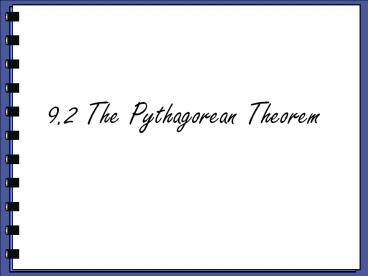9.2 The Pythagorean Theorem - PowerPoint PPT Presentation
Title:
9.2 The Pythagorean Theorem
Description:
9.2 The Pythagorean Theorem Objectives/Assignment Prove the Pythagorean Theorem Use the Pythagorean Theorem to solve problems Assignment: 2-30 even, 42-56 even ... – PowerPoint PPT presentation
Number of Views:442
Avg rating:3.0/5.0
Title: 9.2 The Pythagorean Theorem
1
9.2 The Pythagorean Theorem
2
History Lesson
- Around the 6th century BC, the Greek
mathematician Pythagorus founded a school for the
study of philosophy, mathematics and science.
Many people believe that an early proof of the
Pythagorean Theorem came from this school. - Today, the Pythagorean Theorem is one of the most
famous theorems in geometry. Over 100 different
proofs now exist.
3
Proving the Pythagorean Theorem
- In this lesson, you will study one of the most
famous theorems in mathematicsthe Pythagorean
Theorem. The relationship it describes has been
known for thousands of years.
4
Theorem 9.4 Pythagorean Theorem
- In a right triangle, the square of the length of
the hypotenuse is equal to the sum of the squares
of the legs.
c2 a2 b2 or a2 b2 c2
5
Proving the Pythagorean Theorem
- There are many different proofs of the
Pythagorean Theorem. One is shown below. Other
proofs are found in Exercises 37 and 38 on page
540 and in the Math History feature on page 557.
6
Proof
Given In ?ABC, ?BCA is a right angle. Prove c2
a2 b2
- Plan for proof Draw altitude CD to the
hypotenuse just like in 9.1. Then apply
Geometric Mean Theorem 9.3 which states that when
the altitude is drawn to the hypotenuse of a
right triangle, each leg of the right triangle is
the geometric mean of the hypotenuse and the
segment of the hypotenuse that is adjacent to
that leg.
7
Proof
- Statements
- 1. Draw a perpendicular from C to AB.
- 2. and
- Reasons
- Perpendicular Postulate
- Geometric Mean Thm.
- Cross Product Property
c
a
c
b
a
e
b
f
3. ce a2 and cf b2
4. ce cf a2 b2
4. Addition Property of
5. c(e f) a2 b2
5. Distributive Property
6. Segment Add. Postulate
6. e f c
7. c2 a2 b2
7. Substitution Property of
8
Using the Pythagorean Theorem
- A Pythagorean triple is a set of three positive
integers a, b, and c that satisfy the equation c2
a2 b2 For example, the integers 3, 4 and 5
form a Pythagorean Triple because 52 32 42.
9
Ex. 1 Finding the length of the hypotenuse.
- Find the length of the hypotenuse of the right
triangle. Tell whether the sides lengths form a
Pythagorean Triple.
10
Solution
- (hypotenuse)2 (leg)2 (leg)2
- x2 52 122
- x2 25 144
- x2 169
- x 13
- Because the side lengths 5, 12 and 13 are
integers, they form a Pythagorean Triple. Many
right triangles have side lengths that do not
form a Pythagorean Triple as shown next slide.
- Pythagorean Theorem
- Substitute values.
- Multiply
- Add
- Find the positive square root.
- Note There are no negative square roots until
you get to Algebra II and introduced to
imaginary numbers.
11
Ex. 2 Finding the Length of a Leg
- Find the length of the leg of the right triangle.
12
Solution
- (hypotenuse)2 (leg)2 (leg)2
- 142 72 x2
- 196 49 x2
- 147 x2
- v147 x
- v49 v3 x
- 7v3 x
- Pythagorean Theorem
- Substitute values.
- Multiply
- Subtract 49 from each side
- Find the positive square root.
- Use Product property
- Simplify the radical.
- I already know that you can use a calculator, do
not find the decimal answer unless specifically
asked. Simplify the radical!!
13
Ex. 3 Finding the area of a triangle
- Find the area of the triangle to the nearest
tenth of a meter. - You are given that the base of the triangle is 10
meters, but you do not know the height.
Because the triangle is isosceles, it can be
divided into two congruent triangles with the
given dimensions. Use the Pythagorean Theorem to
find the value of h.
14
Solution
- Steps
- (hypotenuse)2 (leg)2 (leg)2
- 72 52 h2
- 49 25 h2
- 24 h2
- v24 h
- Reason
- Pythagorean Theorem
- Substitute values.
- Multiply
- Subtract 25 both sides
- Find the positive square root.
Now find the area of the original triangle.
15
Area of a Triangle
- Area ½ bh
- ½ (10)(v24)
- 24.5 m2
- The area of the triangle is about 24.5 m2
- (we used decimals because we were asked to!)
16
Ex. 4 Indirect Measurement
- Support Beam The skyscrapers shown on page 535
are connected by a skywalk with support beams.
You can use the Pythagorean Theorem to find the
approximate length of each support beam.
17
- Each support beam forms the hypotenuse of a right
triangle. The right triangles are congruent, so
the support beams are the same length. Use the
Pythagorean Theorem to show the length of each
support beam (x).
18
Solution
- (hypotenuse)2 (leg)2 (leg)2
- x2 (23.26)2 (47.57)2
- x2 v (23.26)2 (47.57)2
- x 52.95
- Pythagorean Theorem
- Substitute values.
- Multiply and find the positive square root.
- Use a calculator to approximate.































